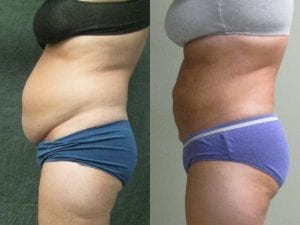In past decades, liposuction was performed on patients in the doctor’s office with the use of local anesthetia or in the hospital under general anesthesia. Today, we are able to offer several options including general anesthesia in an outpatient setting or a “twilight sleep” (conscious sedation).
You and your surgeon will talk about the best anesthesia option for you–considering your medical needs and the type and location of the liposuction to be performed. As a result, you’ll know, before you arrive for surgery, what kind of anesthesia you’ll be having. If you have questions about anesthesia, ask your doctor or the medical staff before surgery. In addition, you may speak directly with the anesthesia team to discuss your concerns prior to your procedure.
Local anesthesia for liposuction procedures may be administered in various ways. For instance, the anesthetist may insert an IV and administer both anesthesia and a sedative through the IV. The IV is used instead of oral medication because it is important for your stomach to be empty in case of a surgical emergency.
Another method of administering local anesthesia is called a “regional block.” Here, medication is applied directly to the nerves in some area of the body, so that you cannot feel the area affected by the nerve block.
A third method is a local anesthetic administered by injection. Local anesthesia is most often used on small areas of the body.
While anesthesia is being administered, you may be asked to count backwards, to describe how some part of your body is feeling, or to respond to the anesthetist in some other way. Your responses help the anesthetist and surgical team determine whether, where, and how well the anesthesia is taking hold, so that surgery does not begin until you are ready.
General anesthesia tends to be a very common method as well. Many patients prefer general anesthesia because they are completely asleep and unaware of what’s going on. There is no discomfort during the procedure and no risk of remembering any pain from the surgery. Some patients may experience some nausea afterwards, but today, this is very uncommon. Anesthesia today is extremely safe and reliable. Also, while you are asleep, local anesthesia is infused into the areas to be suctioned. This diminishes blood loss and also substantially reduces post-operative discomfort.
Ideally, the most uncomfortable part of surgery you will feel is the moment the anesthesia IV or injection is inserted. However, the surgeon’s and anesthetist’s skills, as well as the type and placement of the liposuction you’re having, can also play a role in how much discomfort you’ll feel.
The goal of the surgical team is to help you stay as comfortable and calm as possible. Because anesthesia plays a large role in your comfort and calm during any surgical procedure, it is wise to discuss it with your doctor–so that you know what will happen and will be ready for it.
Below is an example of a typical result.

liposuction abdomen and flanks.

Liposuction Before and After – side facing view
For a free, private consultation about your liposuction options in Cleveland, please call our team at The Cosmetic Surgery Center at (216) 264-8100.
To see more images, please visit our Before and After Gallery
